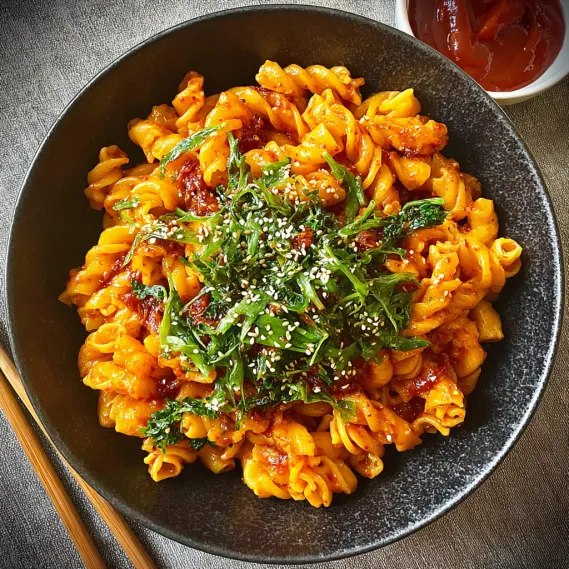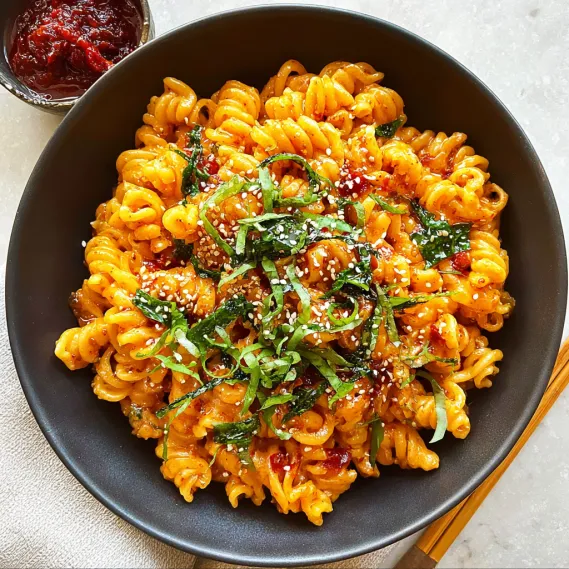 Pin
Pin
This creamy gochujang pasta delivers a perfect balance of spicy and savory flavors in every bite. The Korean chili paste transforms an ordinary pasta dish into something extraordinary, creating a luxurious dinner that feels special but requires minimal effort.
I first made this recipe when craving something spicy yet comforting during a rainy evening. The combination was so addictive that it has now become my go-to impressive dinner when friends visit without warning.
Ingredients
- 8 oz dry Fusilli Corti Bucati Pasta: any pasta shape works beautifully
- 2 tablespoons Gochujang: Korean chili paste provides the signature sweet heat
- 3 cloves garlic: minced adds aromatic depth to the cream sauce
- 4 tablespoons salted butter: creates richness and helps mellow the spice
- 2 tablespoons olive oil: helps prevent butter from burning and adds flavor
- ½ cup shredded parmesan or cheddar cheese: provides salty umami notes
- ½ cup heavy cream: creates the luxurious sauce texture
- ½ teaspoon freshly ground black pepper: optional but adds subtle warmth
- 2 teaspoon chopped parsley: optional for color and freshness
Step-by-Step Instructions
- Boil the Pasta:
- Bring a large pot of water to a rolling boil and add salt if desired. Cook pasta according to package directions until al dente usually 7-12 minutes. The pasta should have a slight bite to it as it will continue cooking slightly in the sauce. Reserve a small cup of pasta water before draining in case you need to adjust sauce consistency later.
- Create the Flavor Base:
- Melt butter and olive oil together in a large sauté pan over medium heat. Add minced garlic and optional black pepper cooking just until fragrant about 30-60 seconds. Watch carefully as garlic burns quickly and will turn bitter. The butter should be gently bubbling but not browning.
- Build the Gochujang Sauce:
- Add the gochujang paste heavy cream and shredded cheese to the pan stirring constantly to create a smooth emulsion. Allow the sauce to simmer gently for 1-2 minutes until it thickens slightly and coats the back of a spoon. The vibrant red color will transform into a beautiful orange-pink cream sauce.
- Combine and Finish:
- Add the drained pasta directly to the sauce and toss thoroughly to coat every piece. If the sauce seems too thick add a splash of reserved pasta water to reach your desired consistency. Continue cooking for another minute allowing the pasta to absorb some of the sauce flavors.
- Plate and Garnish:
- Transfer the finished pasta to serving plates or bowls. Sprinkle with fresh parsley for a pop of color and freshness. Serve immediately while the sauce is still creamy and warm.

The gochujang paste is truly the star of this dish. I remember the first time I introduced this pasta to my spice-cautious friend she was skeptical but ended up asking for seconds and the recipe. The way it creates depth without overwhelming is what makes this sauce so special.
Spice Level Customization
Gochujang varies in spiciness between brands. If you are new to this ingredient start with just one tablespoon and taste before adding more. You can always increase the spiciness but can't take it away. For those who love heat consider adding a teaspoon of gochugaru Korean chili flakes for extra dimension.
Experienced gochujang lovers can try mixing in a small amount of doenjang Korean fermented soybean paste for additional umami complexity. This creates a more traditional Korean flavor profile that pairs beautifully with the creamy pasta base.
Make It A Complete Meal
This gochujang pasta serves as an excellent foundation for protein additions. Grilled chicken seasoned with a little soy sauce and sesame oil complements the flavors perfectly. For seafood lovers sautéed shrimp or scallops add sweetness that balances the spice. Vegetarians can add pan-fried tofu cubes or roasted mushrooms for hearty texture.
For vegetables crisp sugar snap peas thinly sliced bell peppers or baby spinach folded in at the last minute add freshness and nutrition. The slight bitterness of leafy greens particularly works well against the rich cream sauce.
Cultural Fusion Notes
This recipe beautifully represents modern fusion cuisine combining Italian pasta traditions with Korean flavor profiles. Gochujang has been used in Korean cooking for centuries primarily as a flavor enhancer for stews rice dishes and meat preparations. Its fermented nature provides complex umami notes beyond just heat making it an ideal ingredient for creative culinary applications.
While not traditional in either cuisine this combination showcases how global ingredients can create something entirely new and delicious. The pasta provides the perfect vehicle for the bold sauce allowing each bite to carry maximum flavor.
Common Questions About This Recipe
- → What pasta shapes work best with this dish?
Fusilli, bucatini, or any favorite pasta shape pairs well. The sauce clings nicely to spirals or tubes.
- → How spicy is the gochujang-based sauce?
The heat level is moderate, but you can adjust by increasing or reducing the amount of gochujang paste used.
- → Can I add protein or vegetables to this pasta?
Yes! Grilled chicken, shrimp, tofu, or sautéed vegetables like mushrooms, peppers, or zucchini make great additions.
- → How can I make this dish vegan?
Use plant-based butter, milk, and cheese alternatives, and add heartier vegetables or tofu as desired.
- → Are there recommended side dishes?
Korean pickled radishes, kimchi, or a fresh herb salad offer brightness and balance to the bold flavors.
- → What's the best way to store leftovers?
Keep leftovers in an airtight container in the refrigerator for up to five days. Reheat gently before serving.
